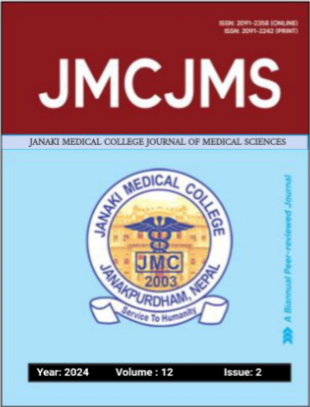Evaluation of lipid profile and hematological parameters among patients attending Ram Janaki Hospital, Janakpurdham
DOI:
https://doi.org/10.3126/jmcjms.v12i02.68956Keywords:
Anthropometric measurements, blood pressure, cardiovascular risk factors, cholesterol, hematological profileAbstract
Background & Objectives: Hematological and lipid profiles play crucial roles in assessing health
conditions and monitoring physiological abnormalities. Hematological and lipid profiles serve as valuable tools in this context, providing insights into various health conditions. However, due to various factors like diet, socioeconomic status, and literacy, these profiles can differ significantly across populations. Therefore, we aimed to find out the hematological as well as biochemical parameters among the patients attending Ram Janaki Hospital, Janakpurdham.
Materials and Methods: This hospital based study involved 140 patients attending the medicine
OPD between September 2023 and February 2024. Anthropometric measurements, blood pressure,
and BMI was calculated. Venous blood samples were collected. Hematological parameters were
assessed using a fully a utomated hematology analyzer, while lipid profiles were evaluated using
semi analyzer Erba Chem 7 analyzer with ErbaDiagnostics kits. Data analysis was performed
using SPSS version 21.
Results: The study population comprised an equal distribution of males and females. Males exhibited
higher values in weight, height, BMI, and blood pressure as compared to females. Hematological
analysis revealed higher hemoglobin levels, red blood cell counts, and packed cell volume in males,
while females showed higher total leukocyte counts. Lipid profile analysis indicated higher total
cholesterol and LDL levels in males, whereas females had higher HDL, triglyceride, and VLDL
levels.
Conclusion: The finding highlights significant gender based differences in anthropometric,
hematological, and biochemical parameters among patients in Janakpurdham. The findings emphasize
the importance of considering gender differences in clinical evaluations and treatment plans. The
observed variations from international norms underscore the need for population specific
reference ranges.
Downloads
Downloads
Published
How to Cite
Issue
Section
License
© JMCJMS, JMC, Janakpur, Nepal




